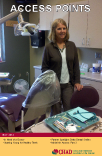We see family issues up close
By: Patricia Patron, Fargo
Here at Family HealthCare Center, we know firsthand about the rising number of families who have no health insurance and have no means to get it.
Twelve percent of North Dakotans lack health insurance. From 2008-09, FHC had a 57 percent increase in the number of patients accessing our discount program (through a sliding fee scale) for seeing the doctor.
As executive director of Family HealthCare Center, I see this every day in our clinic. Many of our patients are young adults working two or more part-time jobs that don't offer health insurance.
At FHC last year, more than 5,000 people, or 41 percent of our patients, did not have access to medical or dental insurance. This means that smaller health concerns that could easily be solved might be put off because there is no money for the doctor visit or medication. When small, untreated health concerns become big issues, it gets that much more expensive.
Our challenge today – as a nation and as a community – is to figure out how to cover the cost difference between serving our community's growing number of uninsured and underinsured and what it really costs to treat someone in a health care setting. This directly affects the economic development of our region. Adequate access to health care services increases life expectancy, improves health of children and adults, and results in higher productivity.
These are hard times for many of us. I urge our community to be considerate of our neighbors who are struggling through this recession – even here in North Dakota and Minnesota. We must work to keep the doors open to accessible, affordable health care. It matters to all of us.

